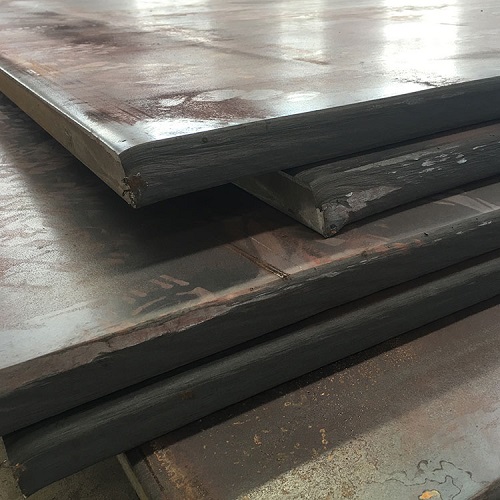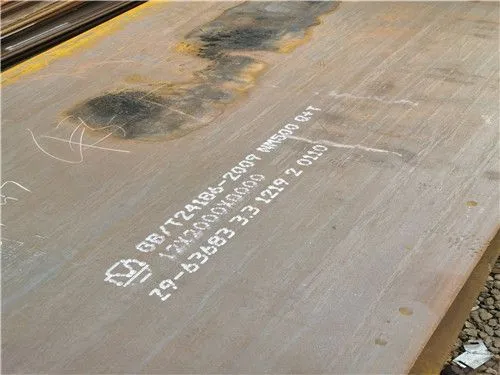Wear-resistant steel plates:
(1) NM360 (wear-resistant 360)
Naming: N is resistance (nai) M is the first pinyin letter of two Chinese characters for grinding (mo), and 360 represents the average Brinell hardness of this steel plates.
Heat treatment: high temperature tempering, quenching + tempering (quenching and tempering)
Application: NM360 wear-resistant steel sheet is widely used in mining machinery, coal mining machinery, environmental
It is also commonly used as high-strength structural steel with yield strength ≥ 700MPa. It is mainly to provide protection for occasions or parts that need to be wear-resistant, so as to make the equipment have a longer life, reduce maintenance downtime caused by maintenance, and correspondingly reduce capital investment.
Performance: The yield is over 800, and the tensile strength is over 1000.
(2) NM400
NM400 is a high-strength wear-resistant steel plates. NM400 has quite high mechanical strength; its mechanical properties are 3 to 5 times that of ordinary low-alloy steel sheets; it can significantly improve the wear resistance of mechanical-related parts; thus improving the service life of machinery and reducing production costs. The surface hardness of this product usually reaches 360~450HB. Applicable structural steel plates for the processing and manufacturing of wear-resistant and vulnerable parts for mines and various construction machinery.
NM400 wear-resistant steel sheet is widely used in construction machinery, mining machinery, coal mining machinery, environmental protection machinery, metallurgical machinery and other product parts. Excavator, loader, bulldozer bucket plate, edge plate, side edge plate, blade. Crusher liners, blades.
(3) Mn13 (standard high manganese steel)
Mn13 is high manganese wear-resistant steel (HIGH MANGANESE STELL SCRAP), which is the best choice among wear-resistant materials such as strong impact and high-pressure material wear.

There are two biggest characteristics of high manganese steel: one is that the greater the external impact, the higher the wear resistance of its own surface layer. When it is impacted, its surface hardness will rapidly increase from HB200 to above HB700, thus producing a highly wear-resistant surface layer. The austenite in the inner layer of the steel plate still maintains good impact toughness; the second is that with the gradual wear of the surface hardened layer, new work-hardened layers will continue to form.
Mn13 rolled steel plate has excellent wear resistance to strong impact wear and high stress wear, will not break during use, and has easy machining properties such as cutting, welding, and bending.
Traditionally used high chromium cast iron has good wear resistance only for moving wear. Mn13 rolled steel plate can effectively reduce the use cost of wearing parts of equipment, save equipment maintenance costs, and improve the competitiveness of finished products.
However, the wear resistance of high manganese steel shows its superiority only under the conditions sufficient to form work hardening, and it is poor in other cases.
The typical Mn17 wear-resistant high-manganese steel is to increase the amount of manganese on the basis of Mn13 steel, which improves the stability of austenite and prevents the precipitation of carbides, thereby improving the strength and plasticity of the steel and improving the work hardening ability of the steel. and abrasion resistance. For example, the service life of ZGMn18 railway forks used in the north is 20%~25% higher than that of ZGMn13.
The grades and scope of application of high manganese steel commonly used in China are: ZGMn13-1 (C 1.10%~1.50%) is used for low-impact parts, ZGMn13-2 (C1.00%~1.40%) is used for ordinary parts, ZGMn13- 3 (C0.90%~1.30%) is used for complex parts, and ZGMn13-4 (C0.90%~1.20%) is used for high impact parts. The manganese content of the above four grades of steel is 11.0% to 14.0%.
For welding and repairing, austenite-based manganese-nickel electrodes (type D256 or D266) should be selected, with a long and thin specification, φ3.2mm×350mm, and the outer coating is alkaline. The operation method adopts DC reverse connection, small current, weak arc, small welding bead and multiple welding layers, and always maintains low temperature and low heat. Beat while welding to eliminate stress. Important castings must be flaw detected. Flash welding (Swiss GAAS80/700 flash welding machine) or MAG welding (such as Nissan YD-S-500) can be used for more important welding, which can effectively ensure the welding seam mechanical properties.
Appendix 1: The concept of hardness
Hardness is a performance index to measure the softness and hardness of materials. There are many methods of hardness testing, the principles are not the same, and the measured hardness values and meanings are not exactly the same. The most common is static load indentation method hardness test, namely Brinell hardness (HB), Rockwell hardness (HRA, HRB, HRC), Vickers hardness (HV), rubber plastic Shore hardness (HA, HD) and other hardness Its value indicates the ability of the surface of the material to resist the intrusion of a hard object. Hardness is not a simple physical quantity, but a comprehensive performance index reflecting the elasticity, plasticity, strength and toughness of materials.
Hardness of steel: The code name of metal hardness is H. According to different hardness test methods, there are mainly the following expressions.
●Conventional expressions include Brinell (HB), Rockwell (HRC), Vickers (HV), Leeb (HL) hardness, etc., among which HB and HRC are more commonly used.
●HB has a wide range of applications, and is generally used when the material is soft, such as non-ferrous metals, steel before heat treatment or after annealing. HRC is suitable for materials with high surface hardness, such as heat treatment hardness, etc.
The difference between the two is that the probes of the hardness testers are different. The probes of the Brinell hardness tester are steel balls, while the probes of the Rockwell hardness tester are diamonds. Under certain conditions, HB and HRC can be exchanged by looking up the table. Its mental calculation formula can be roughly recorded as: 1HRC≈1/10HB.
●HV-suitable for microscopic analysis. Vickers hardness (HV) is pressed into the surface of the material with a load of less than 120kg and a diamond square cone indenter with a vertex angle of 136°, and the surface area of the indentation pit of the material is divided by the load value, which is the Vickers hardness value (HV ). Rockwell hardness (HR-) is determined by the depth of indentation plastic deformation to determine the hardness value index. It is easy to operate, fast and intuitive, and is suitable for mass production.

Attachment 2: Commonly used wear-resistant steel
Domestic (Wugang, Xingang, Wuhan Iron and Steel, Nangang, Baosteel): NM360, NM400, NM450, NM500, NR360, NR400, B-HARD360, B-HARD400, B-HARD450
Swedish wear-resistant steel: HARDOX400, HARDOX450, HARDOX500, HARDOX600, SB-50, SB-45
German wear-resistant steel: XAR400, XAR450, XAR500, XAR600, Dillidur400, Dillidur500
Belgian wear-resistant steel: QUARD400, QUARD450, QUARD500
French wear-resistant steel: FORA400, FORA500, Creusabro4800, Creusabro8000
Finnish wear-resistant steel: RAEX400, RAEX450, RAEX500
Japanese wear-resistant steel: JFE-EH360, JFE-EH400, JFE-EH500, WEL-HARD400, WEL-HARD500.
Post time: Jan-29-2023